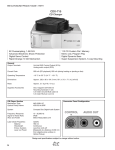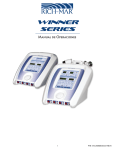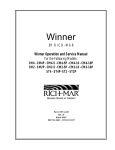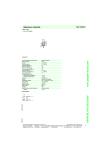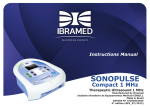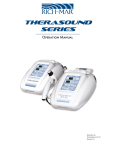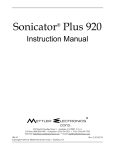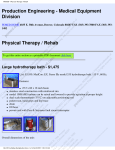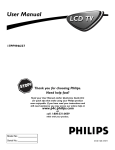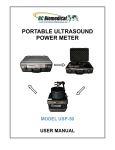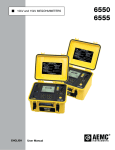Download AutoSound 7.6-5.6 Rev F - Rich
Transcript
Rich-Mar AutoSound 5.6 Ultrasound & AutoSound 7.6 Ultrasound & Stimulation Combination Unit Operation Handbook and Service Manual Part #A2453 Rev F Batch 001 -1- CAUTION This device is not designed to be connected with any electrical equipment unless manufactured and approved by Rich-Mar. These include patient lead cords, self-adhesive electrodes, carbon electrodes, ultrasound lotion, and gel. NOTE: This includes whirlpools and accessories NOT manufactured or approved by Rich-Mar. CAUTION: When using carbon electrodes with any Rich-Mar stimulator (or combination unit), a moistened interface (cloth or sponge) MUST be utilized between these electrodes and the patient to avoid skin irritation and/or electrical burns. WARNING Federal law restricts this device to sale by or on the order of a physician or any other practitioner licensed by the law of the state in which said person practices. For continued protection against fire hazard, replace fuses ONLY with those of the same type and rating. This equipment should always be grounded. Grounding reliability can only be achieved when the equipment is connected to an equivalent marked, “Hospital Grade.” This device should be kept out of the reach of children. -2- Table of Contents Warranties……………………………………………….………………… Device Diagrams……………...…………………………………………... Getting Started…………………………………………….……………… Opening Screen……………………..……………………………………. System Menu……………………………………………………………… Setting Device Defaults…………………….…………………………….. Treatment Screen…………………………………………………………. AutoSound 5.6 & 7.6 Ultrasound Operation Instructions……………... Applying the AutoSound Transducer……………………..…………….. Saving a Treatment as a Preset………………………………………… Combining the AutoSound 5.6 with an External Stimulator………….. AutoSound 7.6 Stimulation Operation Instructions……………………. Stimulation Presets and Treatment Settings…………………………… AutoSound 7.6 Stimulation Intensity Increment Control…….………… AutoSound 7.6 Combination US/Stim Operation Instructions.……….. AutoSound 7.6 Concurrent Stim & Ultrasound Operation Inst……….. AutoSound 5.6 & 7.6 Specifications……………….……………………. Troubleshooting………………………………………………...…………. Cavitation Test…………………………………………………………….. Ultrasound Indications & Contraindications (AutoSound 5.6 & 7.6)…. Stimulation Indications & Contraindications (AutoSound 7.6 only)…... Disinfecting Recommendations…………………………………………… Ultrasound Technical Information (AutoSound 5.6 & 7.6)…………….. Calibrating the AutoSound 5.6 & 7.6 Ultrasound…..…………………... Stimulation Technical Information (AutoSound 7.6 only)………….…... -3- 4 6 7 7 7 7 9 10 13 16 17 18 19 20 22 25 28 29 29 30 31 34 35 39 40 AUTOSOUND 5.6 LIMITED WARRANTY This equipment is sold under an exclusive two-year warranty from date of sale, which warrants it to be free from defects in material and workmanship. We agree to repair or replace at the point of manufacture, without charge, all parts showing such defects, provided the unit is delivered to us, prepaid to our factory, intact for our examination, within two years from date of sale, and provided such examination discloses in our final judgment that it is defective. This warranty does not apply if the equipment has been subject to misuse, neglect, accidents, incorrect wiring (not our own), improper installation, or put to use in violation of instructions furnished by us, has been damaged by excess voltage or has been repaired or altered outside our factory or if the equipment has had its serial number altered or removed. Changes: Rich-Mar reserves the right to modify or change the equipment in whole or in part, at any time prior to delivery, in order to include refinements deemed appropriate by the Company but without incurring any liability to modify or change equipment previously delivered, or to supply new equipment in accordance with earlier specifications. This warranty will be honored only if the enclosed card is filled out and returned to the factory. This warranty is valid only to original purchaser. This warranty is expressly in lieu of all other warranties expressed or implied including the warranties of merchantability and fitness for use and all other obligations on our part, and we neither assume, nor authorize any other person to assume for us, any other liability in connection with the sale or use of this equipment. In no event shall we be liable for consequential or special damages. We make no warranty whatsoever in respect to accessories or parts not supplied by us. AUTOSOUND 7.6 LIMITED WARRANTY This equipment is sold under an exclusive one-year warranty from date of sale, which warrants it to be free from defects in material and workmanship. We agree to repair or replace at the point of manufacture, without charge, all parts showing such defects, provided the unit is delivered to us, prepaid to our factory, intact for our examination, within two years from date of sale, and provided such examination discloses in our final judgment that it is defective. This warranty does not apply if the equipment has been subject to misuse, neglect, accidents, incorrect wiring (not our own), improper installation, or put to use in violation of instructions furnished by us, has been damaged by excess voltage or has been repaired or altered outside our factory or if the equipment has had its serial number altered or removed. Changes: Rich-Mar reserves the right to modify or change the equipment in whole or in part, at any time prior to delivery, in order to include refinements deemed appropriate by the Company but without incurring any liability to modify or change equipment previously delivered, or to supply new equipment in accordance with earlier specifications. This warranty will be honored only if the enclosed card is filled out and returned to the factory. This warranty is valid only to original purchaser. This warranty is expressly in lieu of all other warranties expressed or implied including the warranties of merchantability and fitness for use and all other obligations on our part, and we neither assume, nor authorize any other person to assume for us, any other liability in connection with the sale or use of this equipment. In no event shall we be liable for consequential or special damages. We make no warranty whatsoever in respect to accessories or parts not supplied by us. -4- AutoSound by Rich-Mar TM The AutoSound may prove to be the greatest advancement in therapeutic ultrasound since its inception. The patented design allows you to provide an excellent ultrasound treatment for your patient, eliminating virtually every error that manual application can cause – plus it saves you time for more therapy because it does not require manual application. For those areas that may not be best suited for the AutoSound applicator you also have the option of using the “Therapy Hammer” transducer for manual ultrasound. The Therapy Hammer has a patented dual head design giving you both a 2cm2 and a 5cm2 transducer on a single applicator. The following operating instructions detail its use and parameters. -5- Display Screen Up and Down Arrow buttons Start/Resume button Select button STOP/Pause button Preset button AutoSoundTM 7.6 Combo ultrasound/stim combination device Two channels of stimulation AutoSoundTM 5.6 ultrasound device AutoSound hands-free ultrasound applicator AutoSound straps: Black – long 48” Gray – medium 24” Blue – short 15” -6- Optional “Therapy Hammer” manual ultrasound applicator – has both a 2cm2 and a 5cm2 soundhead on a single transducer AutoSound Operating Instructions Getting Started - Turning the device on Plug the device into an electrical outlet and press the switch located on the back of the device to activate. I is on and O is off. Once the device is completes its diagnostics you will see the Opening Screen. Opening Screen – Accessing System screen or Treatment screen On the Opening Screen you will see the name of the device listed as well as instructions to begin a treatment or to access the System Menu. AutoSound 5.6 Ultrasound Opening Screen AutoSound 7.6 Combo Opening Screen System Menu - Setting unit defaults At the Opening Screen press the SELECT button to access the System Menu for either AutoSoundTM device. At the System Menu, you can adjust the following settings: - Output: You can select to have the output intensity displayed in either Watts or W/cm2. - Contrast: Select the ILM (illumination) setting for the screen contrast. - Presets: Select to either have the presets LOCKED or UNLOCKED. When locked, presets cannot be edited - INC CNTRL: Turn ON, to reduce the rate at which stim levels may be incremented. - Factory Defaults: Will reset system settings to Factory Defaults. - The Tech Menu and Language selections are not operable at this time. Select NOTE: When the “INC CNTRL” Increment Control option is enabled in the System Setup menu, stimulation intensity will increment by 1ma for every five presses of the up or down arrow. This safeguard goes into effect anytime the stim intensity is above a predetermined level. The increment control feature is implemented to avoid accidental, rapid, “jumps” in the level of stim sensation which may be uncomfortable to the patient. A small bar graph alongside the stim intensity indicator shows how close the output is to stepping to the next full intensity level. Example: At the System Setup screen press SELECT until the PRESETS setting is highlighted. Then press one of the arrow keys until LOCKED is displayed. Now the Presets are LOCKED and cannot be changed. To erase any Presets you may have entered and restore the factory default settings, press SELECT until FACTORY DEFAULTS is highlighted and press the UP arrow. “STORING DATA TO -7- EE” will be displayed indicating the factory defaults have been restored over any customer entered presets. Once adjustments have been made to the system settings, press STOP or START to return to the Opening Screen. Select Select Select -8- AutoSound 5.6 & 7.6 Ultrasound Operation Instructions Treatment Screen - Beginning a Treatment On the AutoSound 5.6 pressing the START/RESUME button from the Opening Screen will access the Treatment Screen as seen below. On the AutoSound 7.6 use the arrow keys to select ULTRASOUND and press START/RESUME to display the treatment screen. On the treatment screen the following parameters are displayed: • *Transducer: Displayed in the upper left-hand corner. Indicates which transducer is currently selected. • • • • • • *Selectable between the AutoSound applicator, the manual 2cm2 transducer, and the manual 5cm2 transducer, only if the device has the optional “Therapy Hammer” manual transducer. If your device has only one applicator this option is disabled. Treatment Time: Displayed in the upper-middle. Displays minutes and seconds. Output: Displayed in the upper-right corner. Output can be displayed in either W/cm2 or Watts (see System Menu). US Active: Displayed in lower-left corner. Will indicate if device is currently outputting ultrasound. Frequency: Displayed in the lower middle. Selectable for either 1MHz & 3MHz. Duty Cycle: Displayed to the right of the Frequency. Indicates which duty cycle is active. Selectable between 100%, 50%, 20%, and 10%. P (Preset): Displayed in lower right-hand corner. Indicates the currently active Preset (1 thru 15). Transducer Ultrasound Active Treatment Time Frequency -9- Output Duty Cycle Preset Indicator To access and change Output, Time, Duty Cycle, or Transducer, press the SELECT button until the desired parameter is highlighted. Once highlighted, use the Up and Down Arrow keys scroll through the available settings for that parameter. Please see the following examples on how to set up a treatment. Setting up an ultrasound treatment Example 1: Setting/Adjusting Ultrasound Output Press the SELECT button once to highlight the Output. Use the arrow buttons to set the desired intensity. Note that there is no output at this point, the US ACTIVE indicator remains empty. Output is disabled until treatment is begun. **AutoSound at 3MHz is limited to 1.5 W/cm2. Select Example 2: To Select Treatment Time Press the SELECT button until the Treatment Time is highlighted. Use the arrow buttons to set the desired treatment time. (20:00 minutes maximum) Select - 10 - Example 3: Select Duty Cycle Press the SELECT button until Duty Cycle is highlighted. Use the arrow buttons to select the desired duty cycle. Select Example 4: Select Frequency Press the SELECT button until the Frequency is highlighted, use the arrow buttons to select the treatment frequency. Select - 11 - Notice here that both the 1MHz and the 3MHz frequencies are highlighted (1MHz is solid and 3MHz is gray). This indicates that you have selected the “Frequency Chain” mode that alternates 1MHz and 3MHz output. With each pass of the four crystals the device will automatically alternate between 1MHz and 3MHz providing you the benefits of both frequencies in one treatment. Using the Frequency Chain will assure maximum ultrasound coverage throughout the entire tissue depth, both deep and shallow. Example 5: Selecting a Transducer (if device has optional Therapy Hammer transducer) If your device has the “Therapy Hammer” transducer, the output can be sent to either the 2cm2, 5cm2, or the AutoSound transducer. To change the output device, press the SELECT button until the Transducer setting is highlighted. Use the arrow buttons to select the desired transducer. The Icon below the indicator will change, showing the selected transducer. Select - 12 - Using the AutoSound Transducer If treatment is being performed using the AutoSound transducer, a coupling medium must be applied to the “Gel Well”. Rich-Mar recommends use of AutoGel Pads, which provides excellent conduction, are much easier to use, and create less mess than normal gel. To use the AutoGel Pad, open the pack, spray a little water on the AutoGel if it is not wet, and place it in the Gel Well. Apply the transducer to the patient and secure it with the appropriate size strap. See the pictures below for the appropriate use of the straps. If you do not have AutoGel Pads, you can use Rich-Mar Aloe-Sound Gel Plus or Aloe-Sound Lotion by filling the Gel Well with gel/lotion and applying the AutoSound transducer to the patient. Secure the transducer to the patient with the appropriate strap and method as shown above. **NOTE: The AutoSound applicator is water-resistant but not designed to be submerged for underwater treatment. Submerging the applicator could cause serious damage to the applicator. - 13 - Starting a Treatment Once all treatment parameters have been set, the coupling agent applied, and the transducer properly attached to the patient. Begin treatment by pressing the START/RESUME button. Once the treatment has started: • The timer will begin counting down • The US Active indicator will be filled (indicating ultrasound is being output) • The transducer icon will be depicted as outputting Start Resume Helpful hints: Intensity can be adjusted at any time during a running treatment by pressing the up or down arrow buttons as shown below. The Duty Cycle and Time can be adjusted while treatment is running by pressing the SELECT button until the desired setting is highlighted. Use the arrow buttons to change the parameter. The Frequency and Transducer can also be changed during treatment, by pausing the treatment and using the Select and arrow buttons. ** Remember to move the transducer over the treatment area if using the 2cm2 or 5cm2 manual applicator. Also, ALWAYS use a coupling medium (Gel, Lotion, or AutoGel pad) with any of the transducers to assure conduction. To Pause a Treatment To pause a treatment, press the STOP/PAUSE button or press the Patient Control Switch. - 14 - While treatment is paused: The treatment time indicator will blink and not count down. Intensity will be shown as 00.0 STOP Pause or Patient Control switch -The US ACTIVE indicator blank To Resume a Paused Treatment By pressing the START/RESUME button a paused treatment will resume. Start Resume Stopping a Treatment To stop a running treatment first pause the treatment by pressing STOP/PAUSE or the Patient Control Switch. Once a treatment is paused it can be stopped by pressing the STOP/PAUSE button or the Patient Control Switch again. To Stop treatment, first press STOP/PAUSE or press Patient Control switch to pause: -Treatment time blinking and not counting down STOP Pause or Patient Control switch -The US ACTIVE indicator blank - 15 - Intensity shown as 00.0 Press STOP/PAUSE again or press Patient Control switch again to stop and clear treatment. STOP Pause or Patient Control switch Once a treatment is stopped the original treatment time will be displayed. Saving a Treatment as a Preset The AutoSound allows you to store up to 15 treatments as Presets. To save a treatment as a preset: select the Preset Number to store by pressing the PRESET button, the “P” icon will flash, use the arrow buttons to select the desired Preset (P), set up the treatment to be stored, press and hold the PRESET button until a long beep is heard and the message preset updated is displayed. Example: To save a treatment as Preset 2. Press and release the Preset button, the “P” icon will flash. use the arrow buttons until 2 is displayed under the “P” in the lower right corner, press Preset again. Change the parameters to be saved for this Preset. VERY IMPORTANT – To save these settings as the Preset indicated, press and hold the PRESET button until you hear a beep. After that your displayed treatment is saved as the displayed number Preset (P). You must do this prior to starting the treatment. You cannot save a running treatment as a Preset. Preset Preset Select - 16 - Select Preset Press and hold Preset until you hear a long beep Combining the AutoSound 5.6 Ultrasound with an External Rich-Mar Stimulator The Rich-Mar AutoSound 5.6 is designed to be connected with any Rich-Mar muscle stimulator. Thus enabling the user to provide combination therapy to patients in either a Hands-Free manner with the AutoSound applicator or in a manual technique with the “Therapy Hammer” transducer. To connect the AutoSound 5.6 unit to a stimulator, simply plug an electrode lead from the stimulator into the jack on the lower right front side of the AutoSound ultrasound unit (the jack is next to the “Therapy Hammer” cable coming out of the device). Using the other electrode of the stimulator to complete the circuit with either the “Therapy Hammer” or AutoSound applicator, the user will be able to provide electrical stimulation as well as ultrasound through the transducer. CAUTION: When using a combination treatment, note that both faces of the “Therapy Hammer” transducer and the AutoSound applicator face will output stimulation. CAUTION: When adjusting stimulation levels in combination mode, the ultrasound applicator must remain in contact with the patient. Failure to do so may result in uncomfortable sensation to the patient when the applicator is applied. - 17 - Rich-Mar AutoSound 7.6 Stimulation Operation Instructions The Rich-Mar AutoSoundTM 7.6 Combo is the next generation in the AutoSoundTM line of products. The AutoSound 7.6 Combo provides both the unique Hands-Free ultrasound applicator and stimulation. To begin, plug the device in and turn it on via the power switch. The AutoSound 7.6 Combo will run internal diagnostics and the screen will look like this (the version numbers may differ). Once the device completes its diagnostics, a screen similar to the one below will be displayed. From the Main Menu you can press the Select button to access the System Menu, or use the Arrow Buttons and the Start/Resume button to proceed to the Ultrasound, Stimulation or Combo treatment screens. STIMULATION TREATMENT: From the Main Menu use the arrows to highlight STIMULATION and press Start/Resume. - 18 - The Stimulation Treatment screen will be displayed as shown below. Start Resume There are 15 preset stimulation treatments and 5 different waveforms available on the AutoSound 7.6 Combo*. These are summarized in the following tables: Autosound Stimulation Presets P1 P2 P3 P4 P5 P6 Thru P9 P10 P11 P12 P13 P14 P15 Quadpolar Interferential waveform, Normal mode, 80-150 Hz Scanned Pulse Rate, Vector on. Pre-Mod (Bipolar) Interferential waveform, Normal mode, 2-200 Hz Scanned Pulse Rate, Vector on. Hi-Volt waveform, Normal mode, 100 Hz Fixed Pulse Rate. Pre-Mod (Bipolar) IFC waveform, Alternating mode (channels 1 and 2 alternate, 10 seconds each), 50Hz Fixed Pulse Rate. Russian waveform (50% Duty Cycle), Surge mode (10 seconds on / 30 seconds off), 50 Hz Fixed Pulse Rate. P6 thru P9 are repeats of P1 thru P5 Microcurrent, Normal Mode, 2.7s Fixed Cycle, 500Hz Pulse Rate Same as P1 Same as P2 Same as P5 Same as P3 Same as P10 * NOTE: Some older software versions have only five available presets. WAVEFORMS The following table summarizes the allowed range of settings and options for each waveform. Autosound 7.6 Stimulation Settings Table Vector Mode Quad Interferential On/Off Normal Hi-Volt N/A Normal, Surge*, Alternate** Fixed Only Russian N/A Normal, Surge*, Alternate** Fixed Only Micro N/A Normal Fixed, High, Low, High/Low 2Hz – 200Hz, Pre-Mod Interferential On/Off Normal, Surge*, Alternate** Fixed, High, Low, High/Low 2Hz – 200Hz Pulse Rate Mode Pulse Range 2Hz – 200Hz 2Hz – 200Hz N/A 0ma – 50ma N/A 0ma – 50ma 50us-100us-50us 0ma – 200ma Fixed 50% 0ma – 200ma 0.3Hz to 1000Hz Fixed 2.7s 0µa-999µa Cycle*** Stim Level - 19 - Fixed Only *Surge Mode: Both channels turn on and off together. Options: 5s ON 5s OFF, 5s ON 10s OFF, 10s ON 10s OFF, 10s ON 20s OFF, 10s ON 30s OFF, 10s ON 50s OFF. **Alternate Mode: Channels alternate, while channel 1 is on channel 2 will be off. Options: 5s, 10s, 20s, 30s. ***Cycle Descriptions: Hi-Volt: always two 50µs pulses separated by 100µs. Russian: always operates at a 50% duty cycle. Micro: Pulses alternate polarity every 2.7s All preset treatments default to a 10-minute treatment time, but the treatment time can be adjusted anywhere from 1 to 99 minutes. Stimulation presets can be edited and saved in the same way as ultrasound presets. (See page 16) To select one of the fifteen stimulation presets, press the Preset button and the “P” in the lower left flash. Use the arrows to scroll through the presets until the desired preset is displayed. Press the Preset button once more to select the desired preset. If all parameters except intensity are appropriate for the desired treatment, set the stim intensity and begin treatment as shown below Press the up arrow, the display will change and the stim level will highlight. Notice that the intensity of channel one is being set and the output indicator box to the right of the “CHANNEL 1” label is filled in. This indicates the device is outputting the displayed stimulation parameters on channel 1. NOTE: If the Quadpolar Interferential waveform is selected both channels will be adjusted simultaneously. After setting the Channel 1 stim level, press the Select button once and use the arrows to set the stim level of channel 2 (or the channel balance if using the Quadpolar interferential waveform). Select or Press Select once more or Start to begin treatment. - 20 - Start Resume A stimulation treatment may be paused by pressing the Stop/Pause button. Output will immediately cease, indicated by the intensity displays reading 000 and the output indicator boxes blank as shown below. The treatment time will blink and will not advance. When treatment is paused pressing the arrow buttons will adjust the treatment time up or down. To resume treatment, press the Start/Resume button. STOP Pause or Patient Control switch To Stop Stimulation Treatment: Press the Stop/Pause button or the Patient Control Switch once to pause treatment. Press the Stop/Pause button or the Patient Control Switch again to terminate treatment. Press the Stop/Pause button or the Patient Control Switch a third time to return to the Main Menu. - 21 - AutoSound 7.6 Combination US/Stim Operation Instructions COMBINATION TREATMENT: To begin an ultrasound/stimulation combination treatment. From the main menu use the arrow buttons to highlight COMBO. Press the Start button to access the Combination Treatment Screen seen below. Start Resume AUTOSOUND 7.6 COMBINATION SET UP: Note: in Combination mode the ultrasound transducer becomes the white pin of Channel 2. Attach a lead cord to channel 2 and leave the white pin disconnected. Put an electrode on the red pin, and apply it to the patient. Apply the ultrasound applicator to the patient, the ultrasound applicator will act as the white lead electrode from channel 2 to complete the stimulation circuit. The AutoSound 7.6 will output stimulation on channel 2 only during combination treatment. Channel 1 will be disabled except when the Quadpolar interferential waveform is selected. CAUTION: When adjusting stimulation levels in combination mode, the ultrasound applicator must remain in contact with the patient. Failure to do so may result in uncomfortable sensation to the patient when the applicator is applied. When performing a combination treatment, the Russian waveform is not available. Surge and Alternate modes are also disabled. Select a stimulation preset by pressing the Preset button. The “P” indicator to the left of the waveform description will blink. Use the arrows to scroll through the stimulation presets until the desired preset is displayed. Press the Preset button again, the “P” indicator for the ultrasound presets will begin blinking, use the arrow buttons to select an ultrasound preset. Press the Preset button again or press the Select button to adjust the stimulation intensity, treatment time, ultrasound intensity, transducer, frequency, and duty cycle parameters. Use the arrows to adjust the highlighted parameter. - 22 - The display below shows the stimulation level on channel 2 being adjusted. Select Press Select and use the arrow buttons to adjust the treatment time. Select or Press Select, Highlight the ultrasound intensity, and use the arrows to set the output intensity. Select Press Select, Highlight the duty cycle, and adjust Select or Press Select, Highlight the ultrasound frequency, and set as desired. - 23 - Select or Press Start, treatment will begin. Both stimulation and ultrasound will be output simultaneously, with stimulation coming through the AutoSound ultrasound applicator. The treatment timer will begin to count down. Start Resume To pause a combination treatment, press the Stop/Pause button and output ceases (indicators go blank and intensity displays read 000) and the treatment timer will flash. To resume treatment, press the Start/Resume button. ADJUSTING STIMULATION AND ULTRASOUND INTENSITIES DURING TREATMENT: Press one of the arrow keys while treatment is running to set the stimulation level. After adjusting the stimulation level press Select to highlight and adjust the level balance, ultrasound intensity, and treatment time. To Stop a Combination Treatment: Press the Stop/Pause button once to Pause, twice to cancel the treatment and return to the Combination Treatment Screen, three times to return to the Main Menu. - 24 - AutoSound 7.6 Concurrent Stim & Ultrasound Operation Instructions CONCURRENT STIM AND ULTRASOUND TREATMENTS: The AutoSound 7.6 allows separate ultrasound and stimulation treatments to run simultaneously. Concurrent operation is different from Combination mode, rather than outputting stimulation through the ultrasound applicator the AutoSound 7.6 stimulation and ultrasound sections function separately, as if the AutoSound 7.6 were separate stimulation and ultrasound devices. Start one treatment normally, either ultrasound or stimulation. The press Start again to bring up the concurrent treatment screen. Examples of both are given. Example: Ultrasound treatment started first. Once the ultrasound treatment is running, as in the above screen, with the treatment timer counting down and ultrasound being output. Press the Start button a second time. The screen will split, showing the currently running ultrasound treatment on the right and a new stimulation treatment on the left. Start Resume The ultrasound treatment will continue to run uninterrupted. Stimulation parameters can now be set as in a solo stimulation treatment. Once the stimulation treatment parameters have been set, press Start and the stim timer will begin counting down, now a stim treatment is running concurrently with an ultrasound treatment as shown below. Preset - 25 - Preset Select Start Resume ADJUSTING STIMULATION AND ULTRASOUND INTENSITIES DURING TREATMENT: Press one of the arrow keys while treatment is running to set the stimulation level. After adjusting the stimulation level press Select to highlight and adjust the level balance, ultrasound intensity and treatment times. Example: Stimulation treatment started first. Starting an ultrasound treatment while a stimulation treatment is running is done exactly the same way. With a stim treatment screen displayed, like the one shown below. Press the Start button, the screen will split, and the ultrasound treatment screen will display on the right. Start Resume The stim treatment will continue to run uninterrupted and the ultrasound treatment screen is now shown. Use the Select button to highlight the ultrasound parameters and set up a treatment as for a - 26 - solo ultrasound treatment. The Preset button can also be used to select a preset, as when performing a solo ultrasound treatment. PAUSING CONCURRENT AUTOSOUND 7.6 TREATMENTS: If concurrent stim and ultrasound treatments are running, pressing the Stop/Pause button will pause BOTH treatments. This will be indicated by output ceasing, intensity displays reading 0, output indicators being blank and the treatment times flashing. While paused the Select button and arrows can be used to change treatment parameters if desired. To resume treatment press the Start/Resume button and BOTH treatments will resume. STOP Pause or Patient Control switch Start Resume STOPPING CONCURRENT TREATMENTS: To stop concurrently running treatments, both treatments must be stopped, they cannot be terminated separately. Press the Stop/Pause button to pause output. Press the Stop/Pause button again and the AutoSound display will return to the Main Menu screen. ADJUSTING STIMULATION AND ULTRASOUND INTENSITIES DURING TREATMENT: Press one of the arrow keys while treatment is running to set the stimulation level. After adjusting the stimulation level press Select to highlight and adjust the level balance, ultrasound intensity, and treatment time. To end one treatment without affecting the other, the Select button can be used to highlight the intensity for a treatment. Use the arrow buttons to reduce the intensity to zero for the selected treatment. The electrodes or applicator can now be removed from the patient. - 27 - AutoSound 5.6 Ultrasound Specifications AutoSound 7.6 Combo Specifications Ultrasound Duty Cycles 100%, 50%, 20%, and 10% Ultrasound Duty Cycles Same Ultrasound Output 0-2.0 W/cm2, Note: - AutoSound 3MHz and 1&3MHz Chain are limited to 1.5 W/cm2 Ultrasound Output Same Timer 0-20 minutes Timer 0-20 min ultrasound & combo, 0-99 min. stim Frequencies 1, 3 MHz, or 1& 3MHz Chain Frequencies Same BNR Maximum of 5.5:1 BNR Same ERA AutoSound: 3.5cm2 – treatment area of 14cm2 Therapy Hammer: 2cm2 and 5cm2 ERA AutoSound: 3.5cm2 – treatment area of 14cm2 Therapy Hammer: 2cm2 and 5cm2 Input 115 VAC or 230 VAC Input Same Presets 15 programmable presets Presets 15 progammable US presets , 5 fixed stim presets Patient Control Switch Included Patient Control Switch Same Weight Approx 8lbs. Weight Approx 14 lbs. Dimensions 12”W x 9”D x 7”H Dimensions 12”W x 12”D x 7”H Waveforms Not Applicable Waveforms Quadpolar IFC, Premodulated IFC, High Volt, Russian Power Consumption 100 Watts Power Consumption 100 Watts Fuse 1 Amp Fuse 1 Amp Line Leakage Less than 50 micro amps Line Leakage Less than 50 micro amps - 28 - Trouble-Shooting Rich-Mar Corporation takes pride in its Technical Support Hotline: If you have any questions please contact your distributor or you can contact us at 800.762.4665 in the US, +1.918.543.2222 internationally, or at [email protected]. We have an outstanding staff ready to take your calls and help with diagnosing and troubleshooting problems. Listed below are several options for troubleshooting the AutoSound. 1) The device fails to turn on. Check to verify that the power cord is fully plugged into the corcom power entry module below the AC switch on the rear of the device. Also verify that the power cord is fully plugged into the AC wall outlet. Check the fuse to verify that it has not blown. CAUTION: To ensure personal safety, unplug the unit before checking the fuse. 2) Ultrasonic Active indicator fails to illuminate (box doesn’t black in) Verify that the soundhead connections are plugged firmly into the main board. 3) TEMP indicator comes on next to the Ultrasound Output display. Indicates that the AutoSound applicator is getting too warm and the device will first display TEMP and revert to a 10% pulsed output until it cools – if the device gets too hot it will cease ultrasound output. Check to make sure your intensity level is not too high – if so decrease the intensity. If that does not make the TEMP indicator go away turn off the device and pour some cool water in the gel well. If the TEMP indicator remains on all the time it may indicate that the device may need some service – please call Rich-Mar Technical Service at 800.762.4665. When using the AutoSound 5.6 OR 7.6, check that the soundhead in use is active. Also, be sure to use an adequate amount of coupling gel, an AutoGel pad, or a lotion specifically designed for ultrasound transmission. Cavitation Test / Output Troubleshooting Rich-Mar suggests that ultrasound output be tested once a week. To do this, turn on the device and start a treatment at 100% output. The outputting head should be facing up towards the user. Pour some water on the soundhead and increase the intensity. If the device is outputting ultrasound, the water should cavitate, or bubble, on the soundhead. CAUTION: Do not operate the ultrasound in an “unloaded” condition for more than one minute at intensities greater than 1.0 W/cm2. It is possible that the transducer may overheat and damage the unit. - 29 - Rich-Mar AutoSound 5.6 and 7.6 Ultrasound Indications for Treatment (Therapeutic Ultrasound) Rich-Mar Ultrasound devices are indicated to produce therapeutic deep heat for the following conditions: 1) Relief of pain. 2) Muscle spasms. 3) Joint contractures. But not for the treatment of malignancies. Rich-Mar AutoSound 5.6 and 7.6 Ultrasound Contraindications Ultrasound should not be used in the following areas: 1. Near or over the heart. 2. Near or over the eyes. 3. On the head. 4. Near or over reproductive organs. 5. On the lower back during pregnancy or over the pregnant uterus. 6. Directly over the spinal column. 7. Over growing bone in children. 8. Where the skin suffers from any sensory impairment. 9. Over areas of malignancies. 10. In the area of visceral plexus and large autonomous ganglion. 11. Over the thoracic area if the patient is using a cardiac pacemaker. 12. Over a healing fracture. 13. Over ischemic tissues in individuals with vascular disease where the blood supply would be unable to follow the increase in metabolic demand and tissue necrosis might result. Precautions should be taken when used: 1. Over anesthetized areas. 2. On patients with hemorrhagic diastheses. 3. Ultrasound treatment should not be performed over an area of the spinal cord following laminectomy (i.e.- when major covering tissues have been removed). Caution 1. Excessive doses of ultrasound may cause damage to tissue. Periosteal pain is an indication of excess intensity and if it occurs, the power should be reduced; the transducer should be moved more rapidly over the area being treated; or a lower pulsed duty cycle should be used. 2. If the soundhead has been operated unloaded for an extended period of time, the transducer will get hot. If the soundhead is applied to the patient while the transducer is hot, a burn may result. Warning 1. Do not operate the soundhead in an unloaded condition for extended periods of time (greater than 1 minute) . It is possible that unrepairable damage may occur to the transducer in an unloaded state. - 30 - 2. Use of the AutoSound beyond 12 minutes may cause excessive tissue temperature. If treatments beyond 12 minutes are administered, this should be closely monitored by the health-care professional. Warning Use of controls or adjustments or performance of procedures other than those specified herein may result in hazardous exposure to ultrasonic energy. Restriction of Sale Federal law restricts the sale of this device by (or on the order of) a physician or any other practitioner licensed in the state in which said person practices. Rich-Mar AutoSound 7.6 Muscle Stimulation Indications for Treatment (For Monophasic and Russian Waveforms) Rich-Mar stimulation devices are indicated for the following conditions: 1. Relaxation of muscle spasms. 2. Prevention or retardation of disuse atrophy. 3. Increasing local blood circulation. 4. Muscle re-education. 5. Maintaining or increasing range of motion. 6. Immediate post-surgical stimulation of calf muscles to prevent venous thrombosis. Interferential Current Indications for Treatment Interferential stimulation devices are also indicated for the following conditions: 1. Symptomatic relief of chronic, intractable pain. 2. Management of pain associated with post-traumatic or post-operative conditions. TENS Indications for Treatment 1. Symptomatic relief of chronic, intractable pain. 2. Management of pain associated with post-traumatic or post-operative conditions. Rich-Mar AutoSound 7.6 Muscle Stimulator Contraindications and Warnings Contraindications: This device should not be used in the following areas: 1. On persons wearing a cardiac pacemaker. 2. On persons who have known or suspected malignant lesions. This includes cancer patients. 3. Over the carotid sinus area. 4. Transcerebrally. 5. Over the pregnant uterus. Warnings: - 31 - 1. The long-term effects of chronic electrical stimulation are unknown. 2. Stimulation should not be applied over the carotid sinus nerves, particularly in patients with a know sensitivity to the carotid sinus reflex. 3. Stimulation should not be applied over the neck or mouth. Severe spasm of the laryngeal and pharyngeal muscles may occur and the contractions may be strong enough to close the airway or cause difficulty in breathing. 4. Stimulation should not be applied transthoracically in that the introductions of electrical current in the heart may cause arrhythmias. 5. Stimulation should not be applied transcerebrally. 6. Stimulation should not be applied over swollen, infected, or inflamed areas or skin eruptions, e.g., phlebitis, thrombophlebitis, varicose veins, etc. 7. Stimulation should not be applied over, or in proximity to, cancerous lesions. Precautions: 1. Safety of powered muscle stimulators for use during pregnancy has not been established. 2. Caution should be used for patients with suspected or diagnosed heart problems. 3. Caution should be used for patients with suspected or diagnosed epilepsy. 4. Caution should be used in the presence of the following: a. When there is a tendency to hemorrhage following acute trauma or fracture; b. Following recent surgical procedures when muscle contraction may disrupt the healing process; c. Over the menstruating or pregnant uterus; and d. Over areas of the skin which lack normal sensation. 5. Some patients may experience skin irritation or hypersensitivity due to the electrical stimulation or electrical conductive medium. The irritation can usually be reduced by using an alternate conductive medium, or alternate electrode placement. 6. Electrode placement and stimulation settings should be based on the guidance of the prescribing practitioner. 7. Powered muscle stimulators should be kept out of the reach of children. 8. Powered muscle stimulators should be used only with the leads and electrodes recommended for use by the manufacturer. Adverse Reactions: Adverse reactions to electrical stimulation are usually limited to sensations of discomfort. Excessive stimulation can cause muscle spasms as well as soreness such as can be expected with excessive natural exercise. In all cases, treatment should not exceed the patient’s comfortable tolerance to the stimulation level. Note: Skin irritation and burns beneath the electrodes have been reported with the use of powered muscle stimulators. Rich-Mar AutoSound 7.6 TENS Contraindications and Warnings - 32 - Contraindications 1. Any electrode placement that applies current to the carotid sinus (neck) region. 2. Any use of TENS on patients who have a demand-type cardiac pacemaker. 3. Any electrode placement that causes current to flow transcerebrally (through the head). 4. The use of TENS whenever pain syndromes are undiagnosed, until etiology is established. Warnings: 1. The safety of TENS devices for use during pregnancy or birth has not been established. 2. TGENS is not effective for pain of central origin. (This includes headache.) 3. TENS devices should be used only under the continued supervision of a physician. 4. TENS devices have no curative value. 5. TENS is a symptomatic treatment and as such suppresses the sensation of pain which would otherwise serve as a protective mechanism. 6. The user must keep the device out of the reach of children. 7. Electronic monitoring equipment (such as ECG monitors and ECG alarms) may not operate properly when TENS stimulation is in use. Precautions: 1. Isolated cases of skin irritation may occur at the site of electrode placement following long-term application. 2. Effectiveness is highly dependent upon patient selection by a person qualified in the management of pain patients. Adverse Reactions: Skin irritation and electrode burns are potential adverse reactions. Rich-Mar AutoSound 7.6 Interferential Current Contraindications and Warnings Contraindications: This device should not be used in the following areas: 1. On persons wearing a cardiac pacemaker. 2. On persons who have known or suspected malignant lesions. This includes cancer patients. 3. Over the carotid sinus area. 4. Transcerebrally. 5. Over the pregnant uterus. 6. Interferential current therapy must NOT be used on persons with implants of any electrical nature. Warnings: a. The long-term effects of chronic electrical stimulation (interferential current) are unknown. b. Interferential current should not be applied over the carotid sinus nerves, particularly in patients with a know sensitivity to the carotid sinus reflex. - 33 - c. Interferential current should not be applied over the neck or mouth. Severe spasm of the laryngeal and pharyngeal muscles may occur and the contractions may be strong enough to close the airway or cause difficulty in breathing. d. Interferential current should not be applied transthoracically in that the introductions of electrical current in the heart may cause arrhythmias. e. Interferential current should not be applied transcerebrally. f. Interferential current should not be applied over swollen, infected, or inflamed areas or skin eruptions, e.g., phlebitis, thrombophlebitis, varicose veins, etc. g. Interferential current should not be applied over, or in proximity to, cancerous lesions. Precautions: 1. Safety of interferential current stimulators for use during pregnancy has not been established. 2. Caution should be used for patients with suspected or diagnosed heart problems. 3. Caution should be used for patients with suspected or diagnosed epilepsy. 4. Caution should be used in the presence of the following: a. When there is a tendency to hemorrhage following acute trauma or fracture; b. Following recent surgical procedures when muscle contraction may disrupt the healing process; c. Over the menstruating or pregnant uterus; and d. Over areas of the skin which lack normal sensation. 5. Some patients may experience skin irritation or hypersensitivity due to the electrical stimulation or electrical conductive medium. The irritation can usually be reduced by using an alternate conductive medium, or alternate electrode placement. 6. Electrode placement and stimulation settings should be based on the guidance of the prescribing practitioner. 7. Interferential current stimulators should be kept out of the reach of children. 8. Interferential current stimulators should be used only with the leads and electrodes recommended for use by the manufacturer. Adverse Reactions: Adverse reactions to electrical stimulation are usually limited to sensations of discomfort. Excessive stimulation can cause muscle spasms as well as soreness such as can be expected with excessive natural exercise. In all cases, treatment should not exceed the patients comfortable tolerance to the stimulation level. Note: Skin irritation and burns beneath the electrodes have been reported with the use of interferential stimulators. Disinfecting Recommendations To disinfect the applicator/transducer between therapy treatments, Rich-Mar recommends using a disinfectant cleaner for ultrasound. OSHA addresses the need for prudent infection control (OSHA Instruction CPL 2-2.33C) to include decontamination of equipment between patients. - 34 - Ultrasound Technical Information – AutoSound 5.6 and 7.6 Applicator Type: The ultrasonic radiation fields produced by Rich-Mar therapeutic ultrasound transducers are of the plane wave type and are essentially cylindrical in shape. This type of applicator is referred to as a collimating applicator. Applicator Label: Each Rich-Mar applicator is labeled to provide the user with information on its applicable parameters. The following abbreviations are used on the label. Gen: The Rich-Mar ultrasonic generator for which the applicator is intended. Fig 1. Near Field Distribution f: The operating frequency in MHz for the applicator. Area: The effective radiating area of the applicator in square centimeters. BNR: The Beam Nonuniformity Ratio. Type: Coll-means collimating applicator. Fig 2. Far Field Distribution Near Field/ Far Field: If measurements are made of the sound intensity along the central axis of the beam produced by the applicator, the intensity distribution shows maxima and minima near the applicator and then a gradual decline beyond the last maximum intensity. The “interference” or “near field” is the area in the ultrasound beam extending from the applicator surface to the location of the most distant intensity maximum. In this area, maxima and minima of intensity are located close to each other. This is the area in which most therapeutic application occurs. This is shown in the Figure 1, measured 0.5cm from the transducer face. Beyond this point, the beam has a more uniform intensity and is called the “far field”. Figure 2 shows the far field distribution at 16cm from the transducer face. The preceding descriptions apply for radiation emitted into the equivalent of an infinite medium of distilled, degassed water at 30°C and with line voltage variations in the range of +/-10% of the rated value Transducer Parameters and Tolerances: The Rich-Mar ultrasound units operate at frequencies of either 1MHz or 3MHz +/- 10%. The effective radiating areas (ERA) of the transducers are ten, five, three and a half (3.5), or two square centimeters, - 35 - depending upon the size of the transducer being used. The tolerance for the ERA is +/-25% on the 2, 3.5 and 5 square centimeter transducers. The tolerance for the 10 square centimeter transducers is +0. -25%. The Beam-Nonuniformity-Ratio (BNR) of any Rich-Mar transducer is 5.5:1 or less. 100% Mode When operated in the 100% mode, the generator produces a non-interrupted sinusoidal waveform of one or three MHz. The peak power and average power are therefore the same. The error in indication of radiated power in intensity for the continuous mode does not exceed +/- 14% allowing for a 6% error in the wattmeter, which equals +/- 20%. Pulsed Mode When operated in the pulsed mode, the generator produces a square-wave burst of sinusoidal waveform of 1MHz or 3MHz of 2.5 milliseconds in duration. Depending upon the Rich-Mar model of therapeutic ultrasound in use, the duty cycle can be chosen between 5% and 95% duty. This then implies the repetition rate is selectable between 20 and 380 pulses per second. (This is computed by taking the inverse of the duty cycle 1/380 = .95, 1/20 = .05). The tolerance for the pulsed mode is +/20%. See the following chart for second comparison on %Duty cycle to pulses. % Duty Cycle Pulses/Second (Indicated on front panel of device) 5 10 15 20 25 30 35 40 45 50 55 60 65 70 75 80 85 90 95 20 40 60 80 100 120 140 160 180 200 220 240 260 280 300 320 340 360 380 The error in indication of radiated power in intensity for the pulsed mode does not exceed +/-14% allowing for an allowable 6% error in the wattmeter, which equals +/-20%. Timer Accuracy The Food and Drug Administration requires that the treatment timer accuracy is to within 0.5 minutes for the preset duration of emission for settings less than five minutes, to within 10% of the preset duration of emission for settings from five to ten minutes, and to within one minute of the preset duration of emission for settings greater than ten minutes. Ratio of Temporal Peak to Temporal Average (Rtpa): - 36 - The ratios of temporal peak to temporal average intensities (Rtpa) will vary with the pulse rate of the device. Depending upon the Rich-Mar model of therapeutic ultrasound in use, the duty cycle can be chosen between 5% and 95% duty. The Rtpa is calculated in the following manner: Rtpa = (1/Duty):1 Example 5% duty = .05 (min. duty, max. Rtpa) Rtpa = (1/.05):1 Rtpa = 20:1 Example 95% duty = .95 (max. pulsed duty, min. Rtpa) Rtpa = (1/.95):1 Rtpa = 1.05:1 See the following chart for %Duty cycle to Rtpa comparison. % Duty Cycle Rtpa (Indicated on front panel of device) 5 10 15 20 25 30 35 40 45 50 55 60 65 70 75 80 85 90 95 20:1 10:1 8.33:1 5:1 4:1 3.33:1 2.86:1 2.5:1 2.22:1 2:1 1.82:1 1.66:1 1.54:1 1.43:1 1.33:1 1.25:1 1.18:1 1.11:1 1.05:1 The Rtpa tolerance does not exceed +/- 20%. The temporal maximum intensity for each duty cycle as well as the 100% modulation is whatever is indicated on the meter. The temporal average intensity for each duty cycle will be the meter indication multiplied by the percentage duty cycle. Temporal Average = (Duty) x (Meter Indication) Example, 5 Watts, 35% Duty Temporal Average = .35 x 5 Watts = 1.75 Watts The Spatial Average Intensities for each of these setting will be divided by the transducer’s Effective Radiating Area (ERA) Spatial Average = (Temporal Average)/(ERA) Example, 5 Watts, 35% Duty, 5cm2 Transducer - 37 - Spatial Average = (1.75 Watts)/(5cm2) = 0.35 Watts/cm2 The pulse width (On time) of all Rich-Mar therapeutic ultrasound devices is 2.5 milliseconds (mS). The time between pulses (Off time) in milliseconds is calculated as follows: Pulse width (On time) = 2.5mS Off time = [2.5-2.5(%Duty cycle)]/(%Duty cycle) Where %Duty cycle is represented as a decimal. Please see the following example for computing the Off time for a 10% Duty cycle: Off time=[2.5-2.5(0.10)]/(0.10)=22.5 milliseconds. Additional Technical Notes: The peak power is the same in the pulsed modes as in the 100% modulated mode. Unless otherwise stated, all technical parameters are accurate within +/- 20%. When in the pulse modes the unit is still generating therapeutic heat, although it is an amount reduced by a factor directly related to the duty cycle. The pulse rates are used to allow the practitioner to treat areas of bony prominences without creating periosteal pain. The line leakage is tested in both the forward and reverse polarities to be less than 50 microamperes exceeding all standards for medical devices in this class. The device is designed to meet or exceed UL Standards 2601-1 for medical devices and the Canadian Standards Association C22.2 No. 601.1. - 38 - Ultrasound Calibration and Tuning Procedure for AutoSound 5.6 and 7.6 Ultrasound Service Information Rich-Mar Corporation recommends that all Rich-Mar ultrasonic therapy products be returned to the factory or to a servicing Rich-Mar distributor for service or calibration. It is recommended that the device be calibrated annually or when any major component is changed. Caution Calibration and peaking adjustments must not be attempted unless the person performing these adjustments has the proper test equipment, which must include an acceptable ultrasonic wattmeter, such as the Ohmic UPM-30 or equivalent. Degassed water must be used to obtain accurate readings (4 parts per million of oxygen). Warning Use of controls or adjustments or performance of procedures other than those specified herein may result in hazardous exposure to ultrasonic energy. Calibration and Tuning Procedure Instructions A graphical AutoSound 5.6 calibraton instruction is available on our website, www.richmarweb.com, as a PDF file under the Service tab. Once you have accessed the instructions from the website and still have questions regarding calibration please call the Rich-Mar Service Department at 918.543.2222, ext 232 for additional information. - 39 - AutoSound 7.6 Stimulation Technical Information The AutoSound 7.6 Combo units represent the most sophisticated electrical waveform generation ever developed in electrotherapy. The waveforms are software generated using advanced algorithms in the CPU of the AutoSound 7.6 Combo unit. Each waveform has particular characteristics that are suited to a physiological response. Classic, or Quadpolar Interferential, is conventionally thought to provide the smoothest “feeling” current available for sensory stimulation. Hi-Volt (Monophasic) current provides a net charge effect, when needed, provides low current density stimulation, and historically has been used when an ultrasound combination is utilized. The Russian waveform is thought to be the best waveform for motor contraction. Microcurrent provides sub-sensory stimulation. Within each waveform, a particular pulse rate or “beat’ frequency can be chosen. Low pulse rates (010) are thought to be the best for indications involving chronic problems, while higher pulse rates (80200) are thought to be best for indications involving acute problems. A pulse rate of 50Hz is thought to provide the best motor stimulation (contraction) without rapid fatigue. Broad base protocol conventions exist for all electrical stimulation as described above, but within each waveform, certain parameters are the key to eliciting a particular response. The AutoSound 7.6 Combo units have been programmed to have the most common treatment options as factory waveform default settings. However, the AutoSound 7.6 Combo units are designed to provide the most sophisticated and customized treatments imaginable. Helpful Hint: If you desire further information regarding waveform descriptions, recommended reading to supplement this section is ELECTROTHERAPEUTIC TERMINOLOGY in Physical Therapy, published by the American Physical Therapy Association. For more information, contact the APTA, 1111 North Fairfax Street, Alexandria, VA 22314-1488. Quadpolar Interferential (four pads) Electrical stimulation at higher frequencies (5000Hz) penetrates the skin easily (due to capacitive effects of the skin) but has little therapeutic effect. Lower frequencies (0-200) are therapeutic, yet produce irritation or even pain if applied directly. Interferential current utilizes two high frequencies to pass through the skin barrier and then mixes the two frequencies to produce a low frequency within the tissues. Quadpolar mode is named such because two channels totaling four (quad) electrodes work in conjunction to provide treatment of one site. - 40 - The AutoSound 7.6 Combo stimulators can provide Quadpolar Interferential by producing two separate sine wave outputs. By crossing these electrodes, the two sine waves mix and produce a “beat” frequency within the tissue. This beat is the difference in the two sine wave outputs. Two channels required for Quadpolar I FC The AutoSound 7.6 Combo stimulators produce 5000Hz sine waves from channel one and produce between 5000 and 5200Hz sine waves and channel two. Channels one and two operate in concert to treat one site. The device scans between a low “beat” and a high “beat” setting. Quadpolar Interferential Parameters: Carrier Frequency: 5000Hz Beat Frequency Fixed: 2Hz to 200Hz Beat Frequency Scan Low: 2Hz to 80Hz Beat Frequency Scan High: 80Hz to 150Hz Vector Options: On/Off Alternating Rate:* NA Surge Rates:* On: NA, Off: Na Ramp On: Fixed 3 seconds Ramp Off: Fixed 1 seconds Quadpolar Interferential The Total Output Current = 50mA rms. The meter shown on the display of the AutoSound 7.6 Combo units is listed as rms current. To convert rms to peak current, multiply rms by 1.414. Examples are given below. Meter Reading (ms) Peak Current Milliamps (mA) Conversion (mA) 5 7.1 10 14.1 15 21.2 20 28.2 25 35.4 30 42.4 35 49.5 40 56.6 45 63.6 50 70.7 - 41 - Pre-Mod IFC Interferential Pre-Mod IFC Interferential operates with a carrier frequency but it is premodulated within the AutoSound 7.6 Combo stimulators. This enables a single channel (two-electrode) system to be used. Pre-Mod IFC Interferential can select a pulse rate or a “beat” frequency between 2 and 200Hz. Pre-Mod IFC Interferential Parameters: Carrier Frequency: 5000Hz Beat Frequency Fixed: 2Hz to 200Hz Adjustable Beat Frequency Scan Low: 2Hz to 80Hz Beat Frequency Scan High: 80Hz to 150Hz Vector Options: On/Off Surge and Co-Cont rates: 5/5, 5/10, 10/10, 10/30 10/20 or 10/50 “on/off” Seconds Alternating Rate: 5, 10, 20 or 30 seconds Ramp On: Fixed 3 seconds Ramp Off: Fixed 1 seconds Pre-Mod IFC Interferential The Total Output Current = 50mA rms. The meter shown on the screen of the Theramini is listed as rms current. To convert rms to peak current, multiply rms by 2.34 (1.414/.707). Examples are given below: Meter Reading (ms) Peak Current Milliamps (mA) Conversion (mA) 5 11.7 10 23.4 15 35.1 20 46.8 25 58.5 30 70.1 - 42 - Hi-Volt (Monophasic) The AutoSound 7.6 Combo stimulators also have the capability to produce a Hi-Volt Symmetric Square-Wave Monophasic stimulation having two equal positive phases per pulse. This results in a net charge effect. The polarity of Hi-Volt (Monophasic) will be positive for the red pin for each channel and negative for the white pin. Total Output Current for the Hi-Volt = 200 mA. Hi-Volt (Monophasic) Parameters: Carrier Frequency: Not Applicable Pulse Rate: 2Hz to 200Hz Adjustable Fixed Phase Duration: 50uS Interphase Interval: 100uS Surge and Co-Cont rates: 5/5, 5/10, 10/10, 10/30 10/20 or 10/50 “on/off” Seconds Alternating Rate: 5, 10, 20 or 30 seconds Ramp On: Fixed 3 seconds Ramp Off: Fixed 1 seconds - 43 - Russian Total Output Current = 50 mA rms. Russian is a 2500Hz time-modulated waveform having a sinusoidal frequency that is burst modulated at 50% duty. Russian is available in surge and co-contraction and alternating modes. Russian Russian Parameters: Carrier Frequency: 2500Hz Beat Frequency: Fixed 50Hz Pulse Rate: 2 Hz to 200Hz Fixed Surge and Co-Cont rates: 5/5, 5/10, 10/10, 10/30 10/20 or 10/50 “on/off” Seconds Alternating Rate: 5, 10, 20 or 30 seconds Vector Options: Not Available Ramp On: Fixed 3 seconds Ramp Off: Fixed 1 seconds - 44 - Microcurrent The microcurrent waveform is a low intensity treatment alternating in polarity every 2.7 seconds. Microcurrent is indicated for the following conditions: Symptomatic relief of chronic, intractable pain. Management of pain associated with post-traumatic or post-operative conditions. Carrier Frequency: Not Applicable Pulse Rate: Fixed .3-1000Hz Pulse Rate Chain: Fixed Low, Fixed High Phase Duration: 50mS Interphase Interval: Dependent upon pulse rate Positive/Negative Interval: 2.7 seconds Alternating Rate: Not Applicable Surge Rates: Not Applicable Ramp On: Fixed 3 seconds Ramp Off: Fixed 1 seconds phases alternate from positive to negative every 2.7seconds. The amplitude is adjustable from zero to 999µA. - 45 -














































